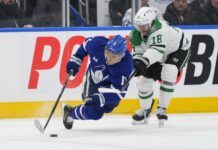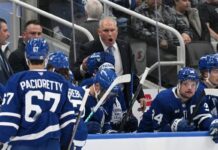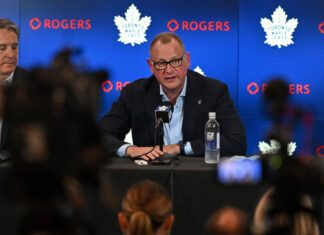According to Darren Dreger and Frank Seravalli, the Maple Leafs and Max Pacioretty are expected to agree to terms before training camp and preseason open later this month.
What type of agreement it will be—a professional tryout or a standard player contract—remains uncertain at the moment, but it is fairly clear at this point that he will be with the Leafs when training camp kicks off.
Editor’s Note: As of Wednesday morning, it’s officially a PTO to start with for Pacioretty.
Max Pacioretty will attend #leafs training camp on a PTO. Expect him to sign a contract before the season.
— Chris Johnston (@reporterchris) September 11, 2024
There are a few different angles to consider when evaluating the move.
The first is the player himself. Pacioretty is set to turn 36 in November and is coming off his first half-season of hockey in three years following two Achilles tears in a five-month span. He did play in 47 games this season with Washington after returning mid-season—a good sign—and he put up four goals and 23 points while averaging 14:26 per night.
The glass-half-full take would be that he shot a stunningly low 4.2 percent (he’s a career 11.1 percent shooter) that is bound to bounce back to some degree. He also spent the summer training and preparing for the season, not recovering from a surgery or a serious injury. That makes a big difference for an NHL player — something OEL admitted he benefited from last season when he rebounded with Florida, for example.
All things considered, Pacioretty produced at a fairly respectable .49 points per game clip last season on a bad Washington team. Would playing on a better team after a summer of training and preparation see his numbers and overall play tick upward?
At 6’2, Pacioretty also adds size to a team that leans small upfront, with all of Max Domi, Mitch Marner, William Nylander, potentially Calle Jarnkrok, and Nick Robertson in top-nine roles, to go along with Connor Dewar and Pontus Holmberg.
The glass-half-empty take: Has he really just hit a wall? He’s turning 36 and tore his Achilles twice. His skating has clearly been impacted, hurting his overall game.
While Pacioretty’s shooting percentage was low, so were his shot rates. His 2.02 shots per game rate was the lowest since his second season in the league nearly 15 years ago. So, too, were his shots per 60. If he’s too slow to get involved and not scoring when he does get looks, he won’t be able to offer much otherwise. Father time is undefeated, and his age and Achilles history may have simply caught up to him.
It could at least be worth the gamble on a cheap, one-year deal, given the Leafs‘ extremely thin depth at the left wing.
Even with Nick Robertson in the fold, 28-year-old Bobby McMann has the inside track at a top-six left-wing spot after just 15 goals and 24 points in 56 games last season at the age of 28 — his first extended time in the league. His main competition is Robertson, who put up 27 points in 56 games last season. Neither rate is far off the 23 in 47 Pacioretty put up, but both players are younger, fresher, and more capable of driving offense themselves.
Pacioretty at least has a track record of production and could serve as insurance should the younger, fresher options falter or simply need the odd day off. The Leafs should be able to keep 13 forwards on the NHL roster, which means they can manage Pacioretty and rotate him and others in and out of the lineup.
But there’s a second side to consider beyond the risk of betting on Pacioretty: the opportunity cost. A shoe will have to drop in some capacity to fit him into the Leafs lineup. The Leafs already have 13 NHL forwards under contract, and it’s unlikely they can keep 14 on the roster. That means someone will have to move to make roster space and cap room.
Who moves impacts how at least part of this potential Pacioretty signing shakes out. Frank Seravalli tweeted that Robertson “is likely” to be traded:
Despite new contract, belief is Nick Robertson is still more likely to be traded than open the season with the #Leafs.
There is still solid interest in Robertson. And it's always easier to trade an asset under contract as opposed to an RFA, which helped him sign.
— Frank Seravalli (@frank_seravalli) September 10, 2024
Earlier in the summer, Nick Kypreos speculated about the Leafs moving David Kampf to clear money, as did Chris Johnston, who also threw Calle Jarnkrok’s name in the mix. Obviously, both are still Maple Leafs, but it’s fair to suggest that if they were on the table earlier this summer, they might still be, considering nothing else has really changed between now and then.
Betting on Pacioretty in a vacuum is reasonable on a cheap deal. Betting on Pacioretty at the cost of trading away a productive young player is a much different bet to consider altogether.
There are so many variables that it’s not worth speculating much further on, but the low-risk nature of any Pacioretty deal should be, in part, measured against who they move out and what they get in return for that player (or players) to make this work. They may move out a pretty good player but grab a good return that helps them be more substantial buyers at the trade deadline.
In essence, this could be quite the rabbit hole to explore, but this move will not be viewed in isolation; it will have a trickle-down effect that impacts the roster on several levels.
It’s fair to wonder if all of it is worthwhile for Max Pacioretty at this point in his career. If they make a good trade to help the team down the road to fit him in, and he holds the fort until the trade deadline, it’s likely fine. If he gives them anything beyond serviceable minutes, it would be really good.
On the other hand, if the Leafs punt a good player to fit him in and Pacioretty struggles, it won’t age so hot.
Based on the reporting as of Tuesday, that’s how I view the situation. Now, we wait to see how it all shakes out, both regarding the nature of the Pacioretty agreement and the impact of the potential addition on the wider roster.

































